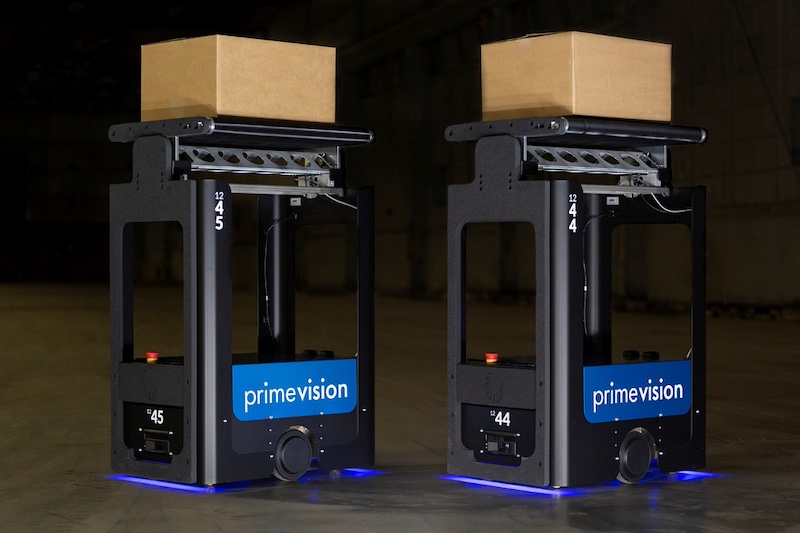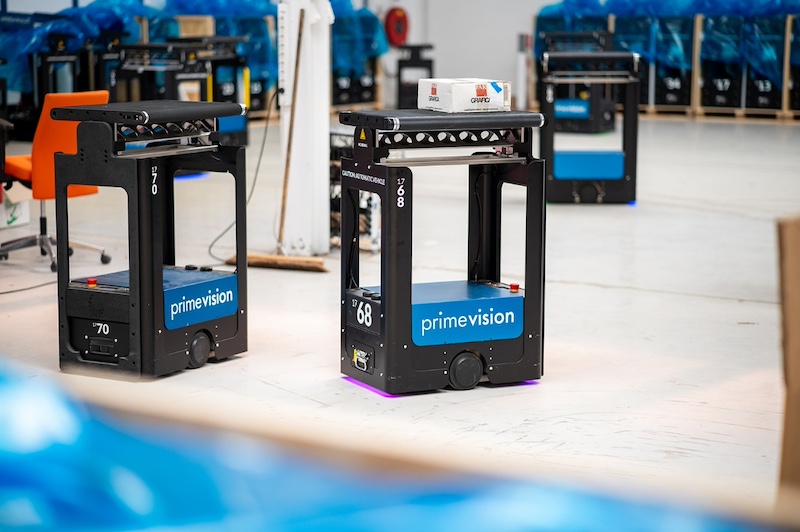
Robots integrate with automated storage and retrieval systems to deliver warehouse efficiency
Automated storage and retrieval systems are becoming the backbone of modern warehouse logistics operations.
However, there is still the challenge of efficiently moving orders through the sorting process. Until recently, the only options were manually or by conveyor – but both have clear limitations.
Nowadays, a more flexible and future-proof solution is available: robots. Tijmen Verkooijen, bid and tender manager at Prime Vision, explains all.
Allowing more items to be stored in less space with easy selection when an order is placed, automated storage and retrieval systems have revolutionised inventory management.
Once the system has transported items to a picking station, they must be packed and sorted to the correct destination. When dealing with the order volumes of e-commerce, achieving this efficiently is a complex task.

Conveying the limitations of sorting
The low-tech approach would be to use warehouse staff. However, introducing people into a sorting process invariably leads to human errors, which affect profitability and customer satisfaction.
Furthermore, moving heavy boxes full of picked items for long periods is unsustainable from a health and safety point of view. Workers can’t be expected to engage in strenuous manual labour all day long.
Conveyors are much more preferable but come with compromises. While they eliminate manual labour, conveyors aren’t always suitable for the complex packing and sorting processes.
Firstly, conveyors are static and can’t easily grow with a business. Consequently, warehouses need to think years into the future when specifying them to ensure spare capacity. With the rapid growth associated with the e-commerce market – this is easier said than done.
Space is another consideration. Conveyors are typically large, so will be a poor choice for a compact sorting area.
There are safety concerns too. Operators packing boxes can end up being hemmed in by conveyors. In the event of a fire for example, safety corridors need to be made to ensure personnel can easily escape.
Finally, there is complexity to consider. A sorting operation with a high number of areas or destinations would end up with a tangle of conveyors to move orders to the correct place. This is expensive, inefficient and a potential nightmare for facility managers and maintenance teams.
A perfect automated partnership
Robots have proven to be the perfect partner for automated storage and retrieval systems.
Using robots eliminates the strenuous work and human errors associated with manual sorting. Unlike conveyors, the fleet can be easily expanded or relocated to accommodate growth or periods of peak demand like Black Friday.
Robots also require less space in which to operate and can individually drive to any destination, which means they can accommodate more restricted spaces or complex sorting processes.
Furthermore, robots don’t surround operators and can be deactivated at the touch of a button, improving safety. In most metrics, robots prove to be the superior option.
In practice, robots can collect packaging from the box erector, then move it to the picking station. An operator can pack the items, with the robot taking the box to the closing machine afterward. Once it is sealed, it can be collected by robot again, and transported to the correct sorting area.
Getting to the destination
As a relatively new solution, robots need to be introduced to operators before widespread adoption. Prime Vision robots navigate within a predefined area via a camera and sensors.
If a robot spots an obstacle, it will stop automatically. Due to this and the required space for manoeuvre, one of the first steps towards a successful implementation is ensuring enough space is available and accurately mapping it.
To know where an order needs to go, robots don’t communicate directly with the automated storage and retrieval system.
Instead, Prime Vision will build an interface with the wider warehouse management system to retrieve sorting information. Once the label on a box has been scanned, the robot receiving it will already know the correct destination.
Robots are not tied to a particular picking station, machine, chute or conveyor, so can seamlessly drive to the right place in the sorting process.
What allows the robots to really excel from an efficiency standpoint is the fleet management system.
Robots can find the optimal path to a particular location, and a set process flow in the clockwise or anticlockwise direction can reduce the number of robots required, but multiple units operating in the same space requires coordination.
Any moment where one robot obstructs another involves a waiting period and reduces sorting efficiency.
To avoid this, the fleet management system evaluates the position of each robot and looks forward in time. By knowing where each unit will be, the system decides which robot to prioritise, slow or steer to reduce moments where robots cross each other, saving time.
Furthermore, with information taken from the warehouse management system, it can assess the current workload and send more robots to busier locations when needed.
Robots sorting in the real-world
Prime Vision has successfully integrated robots with automated storage and retrieval systems at a wide range of sorting operations.
An online motorcycle parts business was able to combine robots with its Intellistore system. When an order is received, a custom box is created that exactly matches the dimensions of the selected items.
Every box is different and products vary greatly, yet the robots are equally proficient at sorting all orders.
Another successful project involved a supplier of baby products with retail stores and an online shop. Robots work together with the Autostore system at the facility, enabling reliable and efficient packing and sorting of items for dispatch to a multitude of destinations.
For customers using automated storage and retrieval systems with complex sorting operations, robots make sense. A complete solution that is inherently flexible, robots have innate advantages over conveyors or manual labour.
As much as automated storage and retrieval systems are changing the way warehouses manage inventory, robots are beginning a concurrent revolution in sorting processes.

